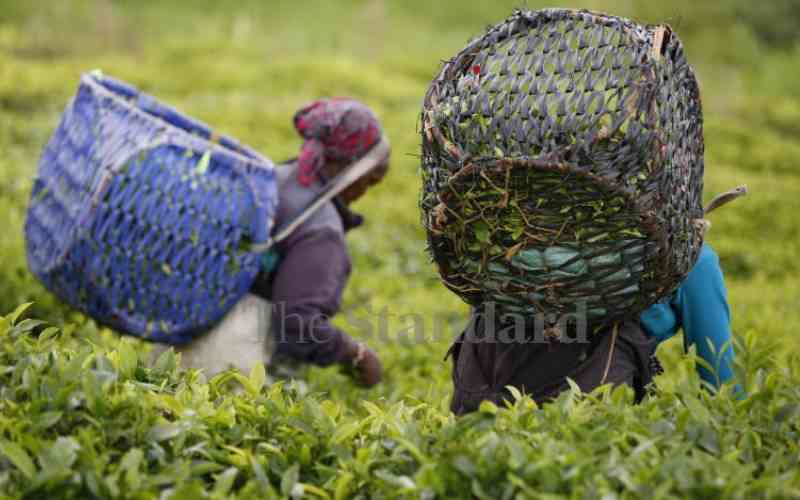 |
|
Industrialist Dr Riyaz Haider from Bio Sustain Tanzania Ltd (left) and IREN Kenya Director James Shikwati discuss how to grow the textiles sector. [PHOTO:JAMES WANZALA/STANDARD] |
The domestic textile market will grow to meet the country's demand if well activated, the sector’s stakeholders have been told. This will make the sector competitive and see the country cut reliance on imported textile materials. The imports are due to fragile cotton value chain capacity that cannot meet demand in terms of volume, price and quantity.
Dr Riyaz Haider from Bio Sustain Tanzania Ltd, said local companies like Puma, among others, collapsed due to poor quality of imported fabrics, noting that the quality standards should be enhanced to ensure growth of the industry in the three East African countries. “Tanzania and Uganda have competitive advantage over Kenya, thanks to the quality standards and policy there. That’s why many textile products are being imported from Tanzania and Uganda to Kenya,” said Riyaz.
He was speaking at the Domestic Textile Market Activation forum at a Nairobi hotel recently, where participants discussed challenges facing and the opportunities that would come with activation of the domestic textile market.The CmiA initiative was launched by German entrepreneur Dr Michael Otto in 2005 to increase the incomes and improve livelihoods of smallholder cotton farmers.
They said rural urbanisation, growth of the retail sector and expansion of the middle-class population in the region offer a unique opportunity to enhance the cotton value chain. This can be done through building of a regional demand alliance.
German Ambassador to Kenya Andreas Peschke said the forum was a great opportunity to learn more on the opportunities and challenges of strengthening an East Africa cotton and textile value chain.
“Cotton is not only the basic source of income for almost 20 million farmers and their families, but is also the basis for further added value in Africa,” said Peschke.
Market distortion
He disclosed that subsidies by major cotton-producing countries such as the US, China and India keep the supply of cotton artificially high and puts pressure on cotton prices, adding that African smallholder farmers are the ones who suffer from the market distortion.
He cited the German Government, which strongly supported the initiative to abolish direct and indirect subsidies to cotton farmers that was brought forward by the so-called C4 countries, namely Benin, Burkina Faso, Mali and Chad, at the 2003 Cancun World Trade Organisation (WTO) negotiations.
“Together with a number of our EU partners, we initiated the EU Africa Partnership for Cotton. Unfortunately, no real progress has been realised in the WTO talks,” said Peschke.
Though importation of textile products from Asian countries is killing the local domestic market, obsolete machines, price competition, levies and taxes, inadequate production capacity and high costs of production in Kenya (at 20 per cent) compared to Tanzania and Uganda’s 12 per cent, are among the other factors hindering growth in the textile industry. Others include lack of regulation of second-hand clothes (Mitumba) as well as lack of promotion of locally-produced textiles.
Inter Region Economic Network Director James Shikwati called on the players in the textile value chain to be conscious of customer preferences.
“Fashionists of textile products should consider consumer tastes to ensure consumption of their products,” said Mr Shikwati, who also called for the improvement of the lives of cotton farmers.
Kenya National Chamber of Commerce and Industry Trade, Investments and Projects Executive Onesmus Masinde said creativity and innovation in the production of textile products value chain will stimulate local and foreign markets. The Tanzanian Director of Domestic Market Development Edwin Rutageruka rooted for a policy intervention that supports both domestic and export markets. He called on stakeholders to rope in the youth and women into fashion trends to make textile products more competitive.
Stay informed. Subscribe to our newsletter
 The Standard Group Plc is a
multi-media organization with investments in media platforms spanning newspaper
print operations, television, radio broadcasting, digital and online services. The
Standard Group is recognized as a leading multi-media house in Kenya with a key
influence in matters of national and international interest.
The Standard Group Plc is a
multi-media organization with investments in media platforms spanning newspaper
print operations, television, radio broadcasting, digital and online services. The
Standard Group is recognized as a leading multi-media house in Kenya with a key
influence in matters of national and international interest.
 The Standard Group Plc is a
multi-media organization with investments in media platforms spanning newspaper
print operations, television, radio broadcasting, digital and online services. The
Standard Group is recognized as a leading multi-media house in Kenya with a key
influence in matters of national and international interest.
The Standard Group Plc is a
multi-media organization with investments in media platforms spanning newspaper
print operations, television, radio broadcasting, digital and online services. The
Standard Group is recognized as a leading multi-media house in Kenya with a key
influence in matters of national and international interest.








